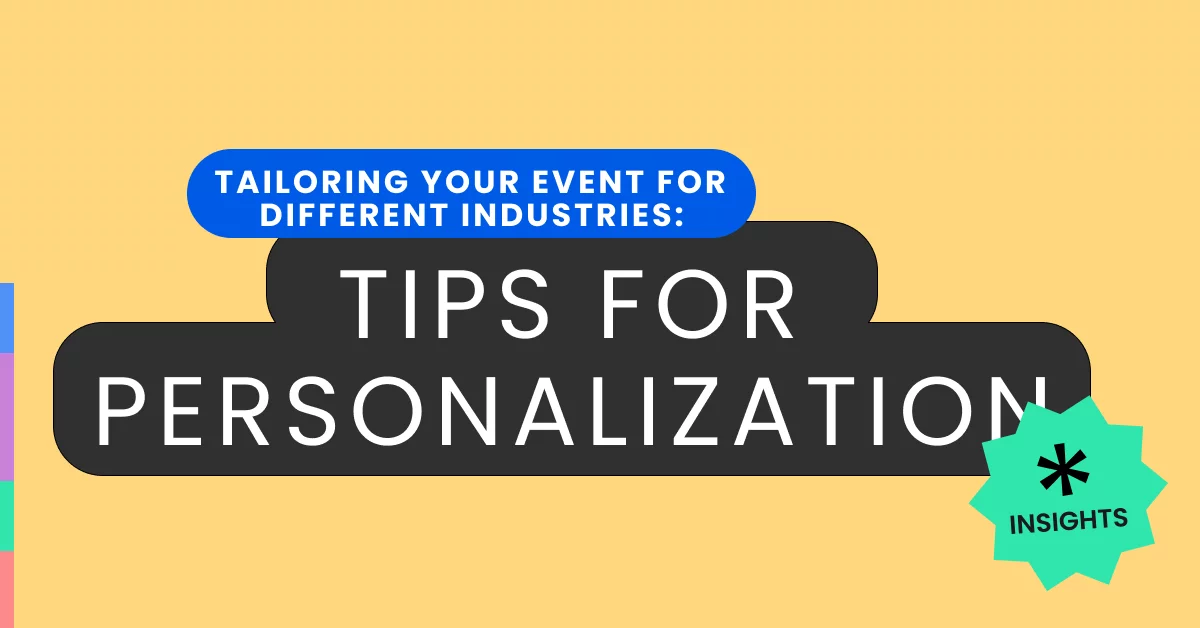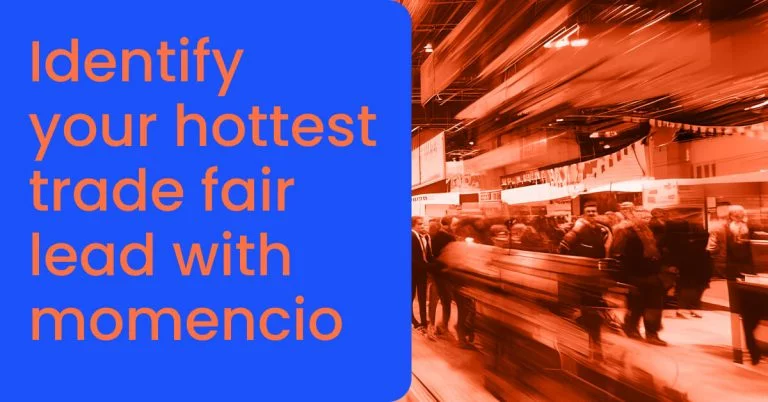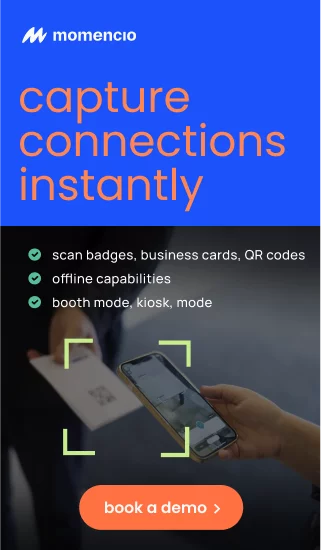Attendees seek unique experiences that resonate with their specific interests. Nobody gets excited about attending a cookie-cutter event anymore. Event personalization is the key to making a lasting impact in an era dominated by generic, one-size-fits-all events.
People want experiences that feel like they were made just for them, not something pulled off a shelf. That’s where personalization comes in. It’s no longer just a nice-to-have; it’s what separates events people remember from the ones they forget by the next day.
In this post, we’ll look at how you can create event experiences that feel personal and relevant to your audience, no matter the industry. From crafting tailored agendas to leveraging data and tech, we’ll cover practical ways to make your events more engaging, impactful, and, most importantly, unforgettable.
TL;DR: Event personalization boosts attendee engagement and satisfaction. Tailor experiences using personalized schedules, targeted content, and interactive technologies. These strategies create meaningful connections with attendees and increase lead capture and event ROI.
What is a personalized experience?
A personalized experience tailors the customer journey to an individual’s unique desires and preferences. This often involves leveraging data about a person’s behavior, interests, or past interactions. In the event sphere, personalization can significantly boost attendee engagement, satisfaction, and loyalty, ultimately driving event attendance and revenue.
Wondering how to tailor your B2C or B2B events? Consider crafting customized agendas, offering pertinent courses and networking opportunities, and distributing tailored handouts or swag bags.
Importance of event personalization
Event planners can harness personalization to curate content, offers, and networking opportunities based on existing attendees’ knowledge. This mirrors how online giants like Amazon and Netflix cater to diverse user preferences.
Why should businesses take event personalization seriously:
Increase engagement: With information overload, capturing attendee attention is paramount. Presenting relevant event content to the right audience at the right time can elicit positive responses and encourage repeat attendance.
Maintain your competitiveness: As consumers grow accustomed to personalized experiences, it’s crucial to adapt. A study revealed that customer experience would overtake price and product as key brand differentiators. Personalization can enhance attendee experiences, setting your events apart.
Increase event ROI: Tailoring content to specific audiences makes your message more compelling, boosting conversion rates. Personalized invitations and emails can drive traffic to your event website and increase registrations.
Build trust and loyalty: While poor personalization can deter attendees, effective use of attendee data can foster trust and long-term relationships.
Competitive differentiation: In a saturated event landscape, personalization can make your event memorable, encouraging repeat attendance and positive word-of-mouth.
Steps to personalize event experiences
Crafting bespoke event experiences demands a strategic approach. Each step builds on the previous one to create an immersive and engaging journey for attendees. Below, we expand on each step with actionable insights and detailed examples.
Step #1: Pre-event data collection:
Data is the backbone of personalization. Gathering and analyzing attendee information helps shape every aspect of the event to meet their preferences.
- What to collect: Use registration forms to gather data like professional roles, interests, goals for attending, and preferred session types. Incorporate questions that uncover deeper insights, such as specific challenges attendees hope to address.
- Segmentation: Group attendees by shared attributes, such as industry, job function, or skill level. For instance, marketers may prefer sessions on digital advertising, while product managers might seek innovation-focused workshops.
- Technology tools: Use event registration platforms or CRMs to automate data collection and segmentation. These tools make it easier to categorize attendees and apply insights throughout the event planning process.
- Outcome: Pre-event data collection ensures your event is structured to address the unique needs of each attendee group.
Step #2: Gamification:
Introduce game elements to boost attendee engagement. Incorporate competition and rewards to stimulate active participation. Gamification transforms passive participation into active engagement by adding elements of fun and competition.
- Examples of gamification:
- Points and badges: Award points for attending sessions, engaging with exhibitors, or completing surveys. Badges can be given for milestones, like visiting a specific number of booths.
- Leaderboards: Showcase top participants on event apps or screens to encourage healthy competition.
- Challenges and rewards: Create challenges, such as scavenger hunts or trivia games, where attendees win prizes for participation.
- Psychological impact: Gamification taps into intrinsic motivations like achievement, recognition, and social interaction, making the event more memorable.
- Technology integration: Use event apps to manage gamified activities seamlessly. Apps can track points, update leaderboards, and send notifications about rewards in real time.
Step #3: Customizable agenda and sessions:
A flexible agenda ensures attendees can choose sessions and activities that align with their interests.
- How to implement:
- Offer a mix of sessions: keynote speeches, workshops, panels, and networking events.
- Use registration data to suggest sessions tailored to attendees’ preferences. For example, an attendee interested in sustainability could receive recommendations for green innovation sessions.
- Technology support: Provide an event app or online portal where attendees can curate their schedules. Include session descriptions, speaker bios, and a “bookmark” feature for easy planning.
- Benefits: A customizable agenda improves engagement by allowing attendees to focus on what’s most valuable to them.
Step #4: Personalized communication:
Use registration data to personalize communications. Start the personalization journey even before the event with tailored communications.
- Pre-event outreach: Use attendee data to craft personalized invitations, emails, and reminders. For example, address individuals by name and mention sessions or networking opportunities relevant to their interests.
- Dynamic content: Create segmented email campaigns based on attendee profiles. For example, exhibitors could receive logistics updates, while attendees could get personalized session recommendations.
- Real-time adjustments: Keep communications adaptable. If a session is filling up quickly, notify attendees who have expressed interest in similar topics.
- Outcome: Personalized communication fosters a sense of connection, making attendees feel valued and excited about the event.
Step #5: Empower attendees:
Involving attendees in shaping their event experience enhances satisfaction and engagement.
- Surveys and polls: Conduct pre-event surveys to gather input on topics, speaker preferences, or preferred event formats. During the event, use live polls to make real-time adjustments.
- Q&A sessions: Allow attendees to submit questions for speakers ahead of time. Highlight popular questions during live sessions.
- Customization options: Give attendees the power to adjust elements of their experience, such as meal preferences, seating arrangements, or session formats.
- Outcome: Empowered attendees are more likely to feel invested in the event and provide positive feedback.
Step #6: Personalized networking opportunities:
Networking is a key driver of event attendance. Tailored networking opportunities can elevate the experience.
- AI-powered matchmaking: Use AI tools to recommend connections based on shared interests, industries, or goals. For instance, a startup founder could be matched with potential investors.
- Networking zones: Create dedicated spaces for networking, categorized by industry or topic. Label these zones clearly to guide attendees.
- Speed networking sessions: Organize brief, one-on-one interactions where participants rotate to meet multiple people in a short time. Allow attendees to select specific industries or themes for these sessions.
- Event apps: Integrate networking features like chat functionality, virtual business card exchange, or attendee directories.
Step #7: Interactive event technology:
Real-time technology enhances the personalization journey and encourages active participation.
- Event apps: Equip attendees with apps offering personalized agendas, live polls, session feedback, and networking recommendations.
- AR/VR experiences: Create immersive sessions or booths that cater to individual interests. For example, an attendee can use VR to explore a virtual showroom.
- Live feedback mechanisms: Use interactive screens or apps to collect attendee feedback during sessions. Adjust content or engagement tactics based on their responses.
- Outcome: Interactive technology keeps attendees engaged and provides planners with valuable data to optimize the event in real time.
Step #8: Post-event follow-up:
Personalization doesn’t end when the event is over. Post-event follow-up is crucial for maintaining relationships and gathering insights.
- Tailored surveys: Send personalized post-event surveys based on attendee segments. For example, exhibitors could be asked about booth traffic, while attendees could provide feedback on session quality.
- Customized content: Share session recordings, presentation slides, or articles related to the topics attendees expressed interest in during the event.
- Nurturing relationships: Use the data collected to craft personalized email campaigns for future events or business opportunities.
- Outcome: Thoughtful follow-up ensures attendees feel valued, boosting loyalty and the likelihood of attending future events.
Advanced attendee engagement strategies
Advanced engagement strategies focus on creating memorable touchpoints to further elevate the attendee experience. These strategies include personalized welcome messages, interactive sessions tailored to individual interests, and gamification elements to encourage active participation. Gamification, especially, has emerged as a powerful tool, transforming conventional events into dynamic and interactive experiences. Moreover, the implementation of real-time feedback mechanisms allows event organizers to adapt to attendee needs on the fly, ensuring a responsive and attendee-centered event environment.
By embracing these advanced personalization and engagement strategies, event planners can significantly enhance attendee satisfaction and loyalty, driving the success of future events. For those looking to integrate these innovative approaches into their event planning and execution, platforms like momencio offer comprehensive solutions, from lead capture to personalized follow-up, ensuring every event is a stepping stone toward greater engagement and business growth. Explore how momencio can revolutionize your event strategies by booking a demo today.
Takeaway
Event personalization is a game-changer. By harnessing data-driven insights and implementing personalized strategies, you can craft memorable experiences that resonate with attendees, fostering long-term loyalty. Elevate your events with the power of personalization.
For those looking to tailor events to various industries, boost ROI, and create unforgettable in-booth experiences, consider leveraging real-time data, targeted engagement strategies, and platforms like Momencio. With its seamless integration and comprehensive event solutions, momencio is your go-to tool for event success.
FAQs
- How can event personalization increase attendee engagement?
- Personalizing an event ensures that attendees receive content and experiences aligned with their interests, significantly boosting their engagement levels and overall event satisfaction.
- What technologies are driving event personalization forward?
- AI for behavior analysis, VR for immersive experiences, and real-time feedback tools are key technologies enhancing personalization and engagement at events.
- Can event personalization impact the ROI of an event?
- Absolutely. By increasing engagement and satisfaction, personalized events can lead to higher conversion rates, repeat attendance, and a stronger overall ROI.
- How can I implement gamification in my event?
- Incorporate elements such as points, badges, and leaderboards tied to event activities or content engagement to encourage participation and competition among attendees.
- What are some challenges of event personalization?
- Challenges include collecting and analyzing attendee data to inform personalization efforts, integrating various tech solutions, and ensuring privacy and data security.













